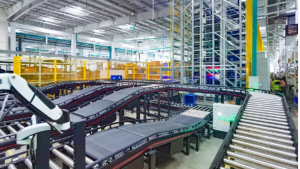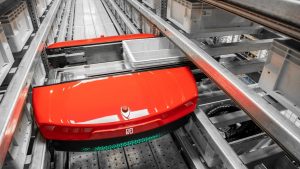Semi-Automated vs. Fully Automated Warehouse System: What Do You Need to Know?
Warehouse automation is critical in modern supply chain management, improving efficiency, accuracy, and cost-effectiveness. It involves critical components such as automated storage and retrieval systems (AS/RS), conveyor systems, and warehouse management systems (WMS), which are essential for an automated warehouse. Implementing these systems can streamline operations, reduce labor costs, and optimize inventory management.
Implementing warehouse automation offers significant cost-effectiveness benefits in labor cost cuts and resource optimization. This article will explore two approaches of automation in the warehouse, i.e., semi-automated and fully automated warehouse systems, for you to understand their differences.
By understanding the benefits and limitations of each system, you can make an informed decision on which type of automation is best suited for your business needs. Let’s dive in!

Key Takeaways:
• Warehouse automation varies in technology integration, human involvement, scalability, cost considerations, and flexibility.
• Fully automated systems use advanced technology with minimal human intervention, while semi-automated systems involve technology and human labor.
• Scalability is better in fully automated systems, while semi-automated systems offer flexibility to adapt quickly to changing business needs.
• Cost considerations favor semi-automated systems due to lower initial investment and maintenance costs.
• Semi-automated solutions immediately aid in goods transportation, order picking, sorting and packing, and inventory management.
Semi-Automated vs. Fully Automated Warehouse: What are the Differences?
Semi-automated and fully automated warehouses vary in technology integration in management and operation. The major differences between the two are:
1) Technology Integration
One of the key differences between semi-automatic and fully automated warehouse structures lies inside the stage of era integration. Fully automated warehouse structures employ advanced technologies like robotics, artificial intelligence, and machine learning to operate seamlessly without human involvement. In contrast, semi-automatic systems combine technology with human labor to streamline operations.
2) Human Involvement
Fully automated warehouses require minimal human intervention, handling tasks from start to finish, including goods transportation, order picking, sorting, packing, and inventory management. In contrast, semi-automated warehouses rely on human operators to oversee and perform tasks alongside automated technologies.
3) Scalability
Fully automated warehouses are designed with scalability in mind, effortlessly supporting increased work scale and adapting to business dynamics. Semi-automated systems, while somewhat scalable, may necessitate additional manual intervention and adjustments as workload increases, potentially limiting their ability to handle sudden surges in demand.
4) Cost Considerations
Installing fully automated warehouse systems involves significant investment due to advanced technologies, resulting in higher initial and maintenance costs. Conversely, semi-automated systems offer a more cost-effective solution that can be implemented gradually, with lower reliance on advanced technologies, reducing maintenance expenses over time.
5) Flexibility and Adaptability
Semi-automated warehouse systems provide greater flexibility and adaptability to meet evolving business needs by allowing easy workflow adjustments, accommodating new product lines, and integrating with other systems. In contrast, fully automated systems, while efficient, may lack the same level of flexibility.

Semi-Automated vs. Fully Automated Warehouse: Strengths and Limitations
▲Warehouse Semi-Automation
There are several advantages that semi-automated warehouse systems offer businesses.
①Flexibility: Semi-automated warehouses offer greater flexibility to adapt to changing business needs and workflows. With fewer fixtures, they can be easily adjusted to accommodate variations in demand and product lines.
②Cost-Effectiveness: Semi-automated systems typically involve lower initial investment and maintenance costs than fully automated setups. This makes them more accessible for businesses with budget constraints.
③Human Oversight: With human operators involved in the process, semi-automated warehouses benefit from human judgment and intervention when necessary. This can help mitigate errors and ensure smoother operations.
Despite benefits, semi-automated warehouse systems also have certain limitations that need to be considered:
①Limited Efficiency: Semi-automated warehouses may not achieve the same level of efficiency and throughput as fully automated systems, particularly in tasks requiring human intervention.
②Human Errors: Despite automation, some tasks in a semi-automated system may still require human intervention, which can introduce potential errors.
▲Warehouse Full-Automation
On the other hand, fully automated warehouse systems offer their own set of benefits and limitations:
①High Level of Efficiency:A fully automated system maximizes efficiency by minimizing human involvement, ensuring precise and fast operations.
②Accuracy and Optimized Space Utilization:With advanced automation technologies, a fully automated warehouse system can optimize space utilization and achieve high inventory accuracy.
However, fully automated warehouse systems also have limitations that must be considered:
①Higher Implementation and Maintenance Costs: Implementing and maintaining a fully automated system can be capital-intensive, requiring significant upfront investment.
②Challenges in Handling Certain Inventory:Some fully automated systems may struggle with handling irregularly shaped, fragile, or highly variable inventory, limiting their applicability in certain warehouse operations.
③Limited Flexibility: Fully automated warehouses may require more effort and resources to be adapted to changing business needs or accommodate variations in workflows compared to semi-automated setups.
In conclusion, the choice between semi-automation and full automation for a warehouse depends on factors such as budget, scalability requirements, efficiency goals, and flexibility needs. In general, semi-automation may be a good way to start as it helps minimize risk with large-scale changes and allows for validation of automation solutions before committing to a full-scale implementation.
What Are the Tasks That Semi-Automated Solutions Can Immediately Help With?
Semi-automated solutions might be adopted for some tasks related to the movement of goods, such as goods transportation, order picking, sorting and packing, and inventory management, and they prove to be a great help. The solutions are classified according to each task:
1) Goods Transportation
Semi-automated warehousing solutions can significantly augment the level of goods transportation in and around the warehouse. Goods can be easily shifted by conveyor systems and shuttle robots, which greatly reduce the need for people and improve efficiency and accuracy overall.
2) Order Picking
Semi-automated solutions can significantly optimize order-picking tasks. With features like order-to-person functionality, workers can access items more easily, reducing travel time and increasing overall picking efficiency, leading to faster and more accurate order fulfillment and, therefore, enhancing customer satisfaction.
3) Sorting and Packing
Sorting and packing can also be applied as semi-automated solutions. Actually, automated sortation systems are effectively able to sort and direct items to their places, while packing stations with automatic packaging equipment can guarantee additional speed and precision in packing operations.
4) Inventory Management
Semi-automated solutions can offer significant improvements in inventory management. For example, barcode scanning and RFID tagging, together with warehouse management systems, can help track inventory and better manage the activity, thus reducing errors and improving inventory accuracy.
HWArobotics Goods-To-Person Solution

HWArobotics offers a comprehensive semi-automated goods-to-person system, including shuttle ASRS, conveyor system, order processing system, and picking station system. This system can be integrated with other systems or modules to perform various warehouse processes, including order-to-person (O2P), spreading, over-storage, reverse logistics, general picking, relay picking, and combination functions.
HWArobotics’s goods-to-person automated warehouse picking system is a high-performance solution that ensures ergonomic site structure through fast and intelligent material supply. By adopting the “goods-to-person” approach, the system optimizes customer order fulfillment while minimizing manual labor and improving overall efficiency.
To explore further how semi-automated goods-to-person solutions can revolutionize your warehouse operations, contact HWArobotics and discover the true warehouse automation potential!







